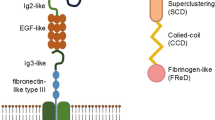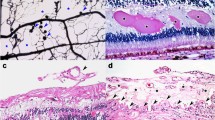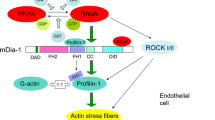Abstract
Diabetic retinopathy (DR) is the leading cause of vision loss in working adults in developed countries. The disease traditionally classified as a microvascular complication of diabetes is now widely recognized as a neurovascular disorder resulting from disruption of the retinal neurovascular unit (NVU). The NVU comprising retinal neurons, glia and vascular cells coordinately regulates blood flow, vascular density and permeability to maintain homeostasis. Disturbance of the NVU during DR can lead to vision-threatening clinical manifestations. A limited number of signaling pathways have been identified for intercellular communication within the NVU, including vascular endothelial growth factor (VEGF), the master switch for angiogenesis. VEGF inhibitors are now widely used to treat DR, but their limited efficacy implies that other signaling molecules are involved in the pathogenesis of DR. By applying a novel screening technology called comparative ligandomics, we recently discovered secretogranin III (Scg3) as a unique DR-selective angiogenic and vascular leakage factor with therapeutic potential for DR. This review proposes neuron-derived Scg3 as the first diabetes-selective neurovascular regulator and discusses important features of Scg3 inhibition for next-generation disease-targeted anti-angiogenic therapies of DR.



Similar content being viewed by others
Data availability
All data are included in this article.
References
Yau JWY, Rogers SL, Kawasaki R et al (2012) Global prevalence and major risk factors of diabetic retinopathy. Diabetes Care 35:556–564. https://doi.org/10.2337/dc11-1909
Worldwide toll of diabetes. https://diabetesatlas.org/en/sections/worldwide-toll-of-diabetes.html. Accessed 18 Jan 2021
Gangaputra S, Lovato JF, Hubbard L et al (2013) Comparison of standardized clinical classification with fundus photograph grading for the assessment of diabetic retinopathy and diabetic macular edema severity. Retina 33:1393–1399. https://doi.org/10.1097/IAE.0b013e318286c952
Bloodworth JM (1962) Diabetic retinopathy. Diabetes 11:1–22
Wolter JR (1961) Diabetic retinopathy. Am J Ophthalmol 51:1123–1141. https://doi.org/10.1016/0002-9394(61)91802-5
Simó R, Stitt AW, Gardner TW (2018) Neurodegeneration in diabetic retinopathy: does it really matter? Diabetologia 61:1902–1912. https://doi.org/10.1007/s00125-018-4692-1
Hoon M, Okawa H, Della Santina L, Wong ROL (2014) Functional architecture of the retina: development and disease. Prog Retin Eye Res 42:44–84. https://doi.org/10.1016/j.preteyeres.2014.06.003
Kur J, Newman EA, Chan-Ling T (2012) Cellular and physiological mechanisms underlying blood flow regulation in the retina and choroid in health and disease. Prog Retin Eye Res 31:377–406. https://doi.org/10.1016/j.preteyeres.2012.04.004
Moran EP, Wang Z, Chen J et al (2016) Neurovascular cross talk in diabetic retinopathy: pathophysiological roles and therapeutic implications. Am J Physiol Heart Circ Physiol 311:H738-749. https://doi.org/10.1152/ajpheart.00005.2016
Duh EJ, Sun JK, Stitt AW (2017) Diabetic retinopathy: current understanding, mechanisms, and treatment strategies. JCI Insight. https://doi.org/10.1172/jci.insight.93751
Geevarghese A, Herman IM (2014) Pericyte-endothelial crosstalk: implications and opportunities for advanced cellular therapies. Transl Res 163:296–306. https://doi.org/10.1016/j.trsl.2014.01.011
Noonan JE, Lamoureux EL, Sarossy M (2015) Neuronal activity-dependent regulation of retinal blood flow. Clin Exp Ophthalmol 43:673–682. https://doi.org/10.1111/ceo.12530
Wang J, O’Sullivan ML, Mukherjee D et al (2017) Anatomy and spatial organization of Müller glia in mouse retina. J Comp Neurol 525:1759–1777. https://doi.org/10.1002/cne.24153
Reichenbach A, Bringmann A (2013) New functions of Müller cells. Glia 61:651–678. https://doi.org/10.1002/glia.22477
Allen NJ, Lyons DA (2018) Glia as architects of central nervous system formation and function. Science 362:181–185. https://doi.org/10.1126/science.aat0473
Grigsby JG, Cardona SM, Pouw CE et al (2014) The role of microglia in diabetic retinopathy. J Ophthalmol 2014:705783. https://doi.org/10.1155/2014/705783
Wong TY, Cheung CMG, Larsen M et al (2016) Diabetic retinopathy. Nat Rev Dis Primers 2:16012. https://doi.org/10.1038/nrdp.2016.12
Barber AJ, Lieth E, Khin SA et al (1998) Neural apoptosis in the retina during experimental and human diabetes. Early onset and effect of insulin. J Clin Invest 102:783–791. https://doi.org/10.1172/JCI2425
Carrasco E, Hernández C, Miralles A et al (2007) Lower somatostatin expression is an early event in diabetic retinopathy and is associated with retinal neurodegeneration. Diabetes Care 30:2902–2908. https://doi.org/10.2337/dc07-0332
Sundstrom JM, Hernández C, Weber SR et al (2018) Proteomic analysis of early diabetic retinopathy reveals mediators of neurodegenerative brain diseases. Invest Ophthalmol Vis Sci 59:2264–2274. https://doi.org/10.1167/iovs.17-23678
Bringmann A, Wiedemann P (2012) Müller glial cells in retinal disease. Ophthalmologica 227:1–19. https://doi.org/10.1159/000328979
Fu Z, Sun Y, Cakir B et al (2020) Targeting Neurovascular interaction in retinal disorders. Int J Mol Sci. https://doi.org/10.3390/ijms21041503
Cerani A, Tetreault N, Menard C et al (2013) Neuron-derived semaphorin 3A is an early inducer of vascular permeability in diabetic retinopathy via neuropilin-1. Cell Metab 18:505–518. https://doi.org/10.1016/j.cmet.2013.09.003
Simó R, Hernández C, European consortium for the early treatment of diabetic retinopathy (EUROCONDOR) (2014) Neurodegeneration in the diabetic eye: new insights and therapeutic perspectives. Trends Endocrinol Metab 25:23–33. https://doi.org/10.1016/j.tem.2013.09.005
Peach CJ, Mignone VW, Arruda MA et al (2018) Molecular pharmacology of VEGF-A isoforms: binding and signalling at VEGFR2. Int J Mol Sci. https://doi.org/10.3390/ijms19041264
Senger DR, van de Water L, Brown LF et al (1993) Vascular permeability factor (VPF, VEGF) in tumor biology. Cancer Metastasis Rev 12:303–324. https://doi.org/10.1007/BF00665960
Simons M, Gordon E, Claesson-Welsh L (2016) Mechanisms and regulation of endothelial VEGF receptor signalling. Nat Rev Mol Cell Biol 17:611–625. https://doi.org/10.1038/nrm.2016.87
Aiello LP, Northrup JM, Keyt BA et al (1995) Hypoxic regulation of vascular endothelial growth factor in retinal cells. Arch Ophthalmol 113:1538–1544. https://doi.org/10.1001/archopht.1995.01100120068012
Froger N, Matonti F, Roubeix C et al (2020) VEGF is an autocrine/paracrine neuroprotective factor for injured retinal ganglion neurons. Sci Rep 10:12409. https://doi.org/10.1038/s41598-020-68488-z
Pierce EA, Avery RL, Foley ED et al (1995) Vascular endothelial growth factor/vascular permeability factor expression in a mouse model of retinal neovascularization. Proc Natl Acad Sci U S A 92:905–909. https://doi.org/10.1073/pnas.92.3.905
Stone J, Itin A, Alon T et al (1995) Development of retinal vasculature is mediated by hypoxia-induced vascular endothelial growth factor (VEGF) expression by neuroglia. J Neurosci 15:4738–4747
Hoang QV, Linsenmeier RA, Chung CK, Curcio CA (2002) Photoreceptor inner segments in monkey and human retina: mitochondrial density, optics, and regional variation. Vis Neurosci 19:395–407. https://doi.org/10.1017/s0952523802194028
Yu DY, Cringle SJ (2001) Oxygen distribution and consumption within the retina in vascularised and avascular retinas and in animal models of retinal disease. Prog Retin Eye Res 20:175–208. https://doi.org/10.1016/s1350-9462(00)00027-6
Gonzalez FJ, Xie C, Jiang C (2018) The role of hypoxia-inducible factors in metabolic diseases. Nat Rev Endocrinol 15:21–32. https://doi.org/10.1038/s41574-018-0096-z
Krock BL, Skuli N, Simon MC (2011) Hypoxia-induced angiogenesis: good and evil. Genes Cancer 2:1117–1133. https://doi.org/10.1177/1947601911423654
Calvo PM, Pastor AM, de la Cruz RR (2018) Vascular endothelial growth factor: an essential neurotrophic factor for motoneurons? Neural Regen Res 13:1181–1182. https://doi.org/10.4103/1673-5374.235024
Byeon SH, Lee SC, Choi SH et al (2010) Vascular endothelial growth factor as an autocrine survival factor for retinal pigment epithelial cells under oxidative stress via the VEGF-R2/PI3K/Akt. Invest Ophthalmol Vis Sci 51:1190–1197. https://doi.org/10.1167/iovs.09-4144
Ruan G-X, Kazlauskas A (2012) VEGF-A engages at least three tyrosine kinases to activate PI3K/Akt. Cell Cycle 11:2047–2048. https://doi.org/10.4161/cc.20535
Sepah YJ, Sadiq MA, Boyer D et al (2016) Twenty-four-month outcomes of the ranibizumab for edema of the macula in diabetes–protocol 3 with high dose (READ-3) study. Ophthalmology 123:2581–2587. https://doi.org/10.1016/j.ophtha.2016.08.040
Ho AC, Busbee BG, Regillo CD et al (2014) Twenty-four-month efficacy and safety of 0.5 mg or 2.0 mg ranibizumab in patients with subfoveal neovascular age-related macular degeneration. Ophthalmology 121:2181–2192. https://doi.org/10.1016/j.ophtha.2014.05.009
Li W, Webster KA, LeBlanc ME, Tian H (2018) Secretogranin III: a diabetic retinopathy-selective angiogenic factor. Cell Mol Life Sci 75:635–647. https://doi.org/10.1007/s00018-017-2635-5
Hosaka M, Watanabe T (2010) Secretogranin III: a bridge between core hormone aggregates and the secretory granule membrane. Endocr J 57:275–286. https://doi.org/10.1507/endocrj.k10e-038
Tanabe A, Yanagiya T, Iida A et al (2007) Functional single-nucleotide polymorphisms in the secretogranin III (SCG3) gene that form secretory granules with appetite-related neuropeptides are associated with obesity. J Clin Endocrinol Metab 92:1145–1154. https://doi.org/10.1210/jc.2006-1808
Maeda Y, Kudo S, Tsushima K et al (2018) Impaired processing of prohormones in secretogranin III-null mice causes maladaptation to an inadequate diet and stress. Endocrinology 159:1213–1227. https://doi.org/10.1210/en.2017-00636
Kingsley DM, Rinchik EM, Russell LB et al (1990) Genetic ablation of a mouse gene expressed specifically in brain. EMBO J 9:395–399
LeBlanc ME, Wang W, Chen X et al (2017) Secretogranin III as a disease-associated ligand for antiangiogenic therapy of diabetic retinopathy. J Exp Med 214:1029–1047. https://doi.org/10.1084/jem.20161802
Ramasamy R, Yan SF, Schmidt AM (2011) Receptor for AGE (RAGE): signaling mechanisms in the pathogenesis of diabetes and its complications. Ann N Y Acad Sci 1243:88–102. https://doi.org/10.1111/j.1749-6632.2011.06320.x
Rong X, Tian H, Yang L, Li W (2019) Function-first ligandomics for ocular vascular research and drug target discovery. Exp Eye Res 182:57–64. https://doi.org/10.1016/j.exer.2019.03.009
Freyberger H, Bröcker M, Yakut H et al (2000) Increased levels of platelet-derived growth factor in vitreous fluid of patients with proliferative diabetic retinopathy. Exp Clin Endocrinol Diabetes 108:106–109. https://doi.org/10.1055/s-2000-5803
Watanabe D, Suzuma K, Matsui S et al (2005) Erythropoietin as a retinal angiogenic factor in proliferative diabetic retinopathy. N Engl J Med 353:782–792. https://doi.org/10.1056/NEJMoa041773
Aiello LP, Avery RL, Arrigg PG et al (1994) Vascular endothelial growth factor in ocular fluid of patients with diabetic retinopathy and other retinal disorders. N Engl J Med 331:1480–1487. https://doi.org/10.1056/NEJM199412013312203
Matsunaga N, Chikaraishi Y, Izuta H et al (2008) Role of soluble vascular endothelial growth factor receptor-1 in the vitreous in proliferative diabetic retinopathy. Ophthalmology 115:1916–1922. https://doi.org/10.1016/j.ophtha.2008.06.025
Takeda A, Baffi JZ, Kleinman ME et al (2009) CCR3 is a target for age-related macular degeneration diagnosis and therapy. Nature 460:225–230. https://doi.org/10.1038/nature08151
Dowler JGF (2003) Laser management of diabetic retinopathy. J R Soc Med 96:277–279. https://doi.org/10.1258/jrsm.96.6.277
Whitcup SM, Cidlowski JA, Csaky KG, Ambati J (2018) Pharmacology of corticosteroids for diabetic macular edema. Invest Ophthalmol Vis Sci 59:1–12. https://doi.org/10.1167/iovs.17-22259
Mansour SE, Browning DJ, Wong K et al (2020) The evolving treatment of diabetic retinopathy. Clin Ophthalmol 14:653–678. https://doi.org/10.2147/OPTH.S236637
Honasoge A, Nudleman E, Smith M, Rajagopal R (2019) Emerging insights and interventions for diabetic retinopathy. Curr Diab Rep 19:100. https://doi.org/10.1007/s11892-019-1218-2
Stewart MW (2016) Treatment of diabetic retinopathy: recent advances and unresolved challenges. World J Diabetes 7:333–341. https://doi.org/10.4239/wjd.v7.i16.333
Holash J, Davis S, Papadopoulos N et al (2002) VEGF-Trap: a VEGF blocker with potent antitumor effects. Proc Natl Acad Sci U S A 99:11393–11398. https://doi.org/10.1073/pnas.172398299
Papadopoulos N, Martin J, Ruan Q et al (2012) Binding and neutralization of vascular endothelial growth factor (VEGF) and related ligands by VEGF trap, ranibizumab and bevacizumab. Angiogenesis 15:171–185. https://doi.org/10.1007/s10456-011-9249-6
Ellis MP, Lent-Schochet D, Lo T, Yiu G (2019) Emerging concepts in the treatment of diabetic retinopathy. Curr Diab Rep 19:137. https://doi.org/10.1007/s11892-019-1276-5
Mira F, Paulo M, Henriques F, Figueira J (2017) Switch to aflibercept in diabetic macular edema patients unresponsive to previous anti-VEGF therapy. J Ophthalmol 2017:5632634. https://doi.org/10.1155/2017/5632634
Kazazi-Hyseni F, Beijnen JH, Schellens JHM (2010) Bevacizumab. Oncologist 15:819–825. https://doi.org/10.1634/theoncologist.2009-0317
Grunwald JE, Pistilli M, Daniel E et al (2017) Incidence and growth of geographic atrophy during 5 years of comparison of age-related macular degeneration treatments trials. Ophthalmology 124:97–104. https://doi.org/10.1016/j.ophtha.2016.09.012
Tang F, LeBlanc ME, Wang W et al (2019) Anti-secretogranin III therapy of oxygen-induced retinopathy with optimal safety. Angiogenesis 22:369–382. https://doi.org/10.1007/s10456-019-09662-4
Acknowledgements
We would like to thank Dr. Yingbin Fu for scientific discussion. This work was supported by NIH R01EY027749 (WL), R24EY028764 (WL and KAW), R24EY028764-01A1S1 (WL and KAW), R43EY031238 (HT, KAW and WL), R43EY031643 (HT), R41EY027665 (WL and HT), American Diabetes Association 1-18-IBS-172 (WL), NIH P30EY002520, Knights Templar Eye Foundation Endowment in Ophthalmology (WL) and an unrestricted institutional grant from Research to Prevent Blindness (RPB) to Department of Ophthalmology, Baylor College of Medicine.
Author information
Authors and Affiliations
Contributions
All authors were responsible for drafting the article and revising it critically for important intellectual content. All authors approved the version to be published.
Corresponding author
Ethics declarations
Conflict of interest
HT and WL are shareholders of Everglades Biopharma, LLC and LigandomicsRx, LLC. WL is the inventor of pending patents related to ligandomics and anti-Scg3 therapy.
Ethical approval
Not applicable.
Consent to participate
Not applicable.
Consent for publication
Not applicable.
Additional information
Publisher's Note
Springer Nature remains neutral with regard to jurisdictional claims in published maps and institutional affiliations.
Rights and permissions
About this article
Cite this article
Ji, L., Tian, H., Webster, K.A. et al. Neurovascular regulation in diabetic retinopathy and emerging therapies. Cell. Mol. Life Sci. 78, 5977–5985 (2021). https://doi.org/10.1007/s00018-021-03893-9
Received:
Revised:
Accepted:
Published:
Issue Date:
DOI: https://doi.org/10.1007/s00018-021-03893-9




